parts Hyundai Elantra 2018 Owner's Manual
[x] Cancel search | Manufacturer: HYUNDAI, Model Year: 2018, Model line: Elantra, Model: Hyundai Elantra 2018Pages: 526, PDF Size: 17.2 MB
Page 5 of 526
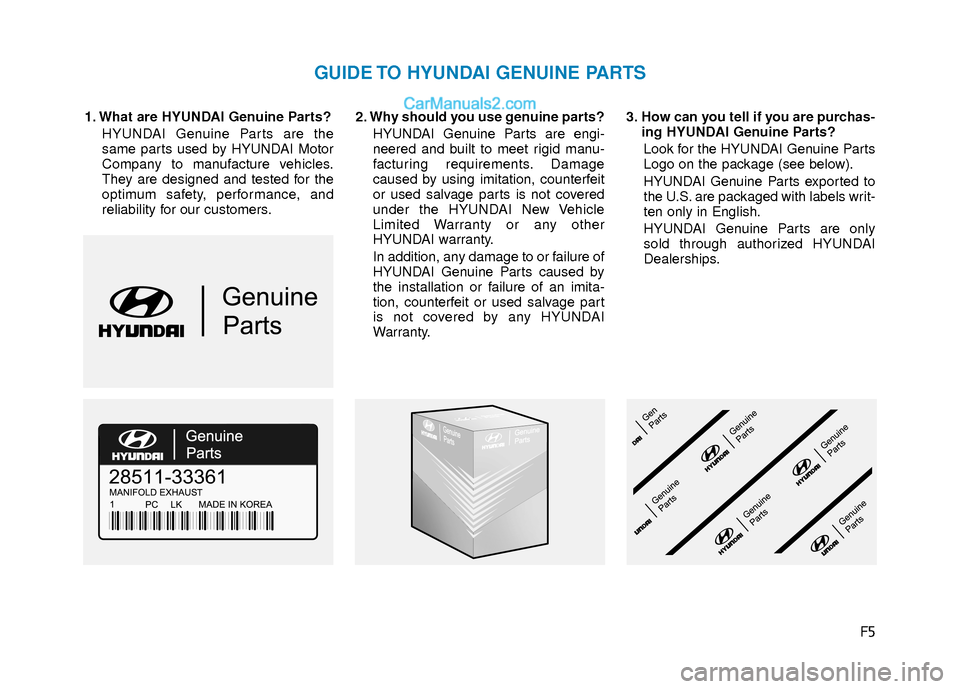
F5
1. What are HYUNDAI Genuine Parts?
HYUNDAI Genuine Parts are the
same parts used by HYUNDAI Motor
Company to manufacture vehicles.
They are designed and tested for the
optimum safety, performance, and
reliability for our customers. 2. Why should you use genuine parts?
HYUNDAI Genuine Parts are engi-
neered and built to meet rigid manu-
facturing requirements. Damage
caused by using imitation, counterfeit
or used salvage parts is not covered
under the HYUNDAI New Vehicle
Limited Warranty or any other
HYUNDAI warranty.
In addition, any damage to or failure of
HYUNDAI Genuine Parts caused by
the installation or failure of an imita-
tion, counterfeit or used salvage part
is not covered by any HYUNDAI
Warranty. 3. How can you tell if you are purchas-
ing HYUNDAI Genuine Parts?
Look for the HYUNDAI Genuine Parts
Logo on the package (see below).
HYUNDAI Genuine Parts exported to
the U.S. are packaged with labels writ-
ten only in English.
HYUNDAI Genuine Parts are only
sold through authorized HYUNDAI
Dealerships.
GUIDE TO HYUNDAI GENUINE PARTS
Page 10 of 526
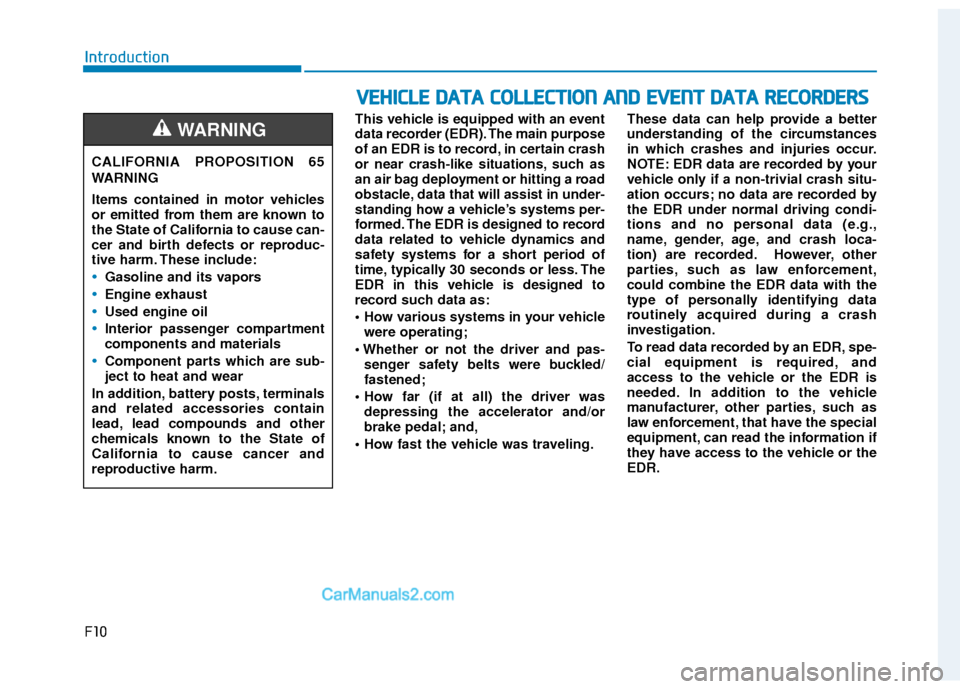
F10
Introduction
This vehicle is equipped with an event
data recorder (EDR). The main purpose
of an EDR is to record, in certain crash
or near crash-like situations, such as
an air bag deployment or hitting a road
obstacle, data that will assist in under-
standing how a vehicle’s systems per-
formed. The EDR is designed to record
data related to vehicle dynamics and
safety systems for a short period of
time, typically 30 seconds or less. The
EDR in this vehicle is designed to
record such data as:
were operating;
senger safety belts were buckled/
fastened;
depressing the accelerator and/or
brake pedal; and,
These data can help provide a better
understanding of the circumstances
in which crashes and injuries occur.
NOTE: EDR data are recorded by your
vehicle only if a non-trivial crash situ-
ation occurs; no data are recorded by
the EDR under normal driving condi-
tions and no personal data (e.g.,
name, gender, age, and crash loca-
tion) are recorded. However, other
parties, such as law enforcement,
could combine the EDR data with the
type of personally identifying data
routinely acquired during a crash
investigation.
To read data recorded by an EDR, spe-
cial equipment is required, and
access to the vehicle or the EDR is
needed. In addition to the vehicle
manufacturer, other parties, such as
law enforcement, that have the special
equipment, can read the information if
they have access to the vehicle or the
EDR.
V V
E
EH
H I
IC
C L
LE
E
D
D A
A T
TA
A
C
C O
O L
LL
LE
E C
CT
T I
IO
O N
N
A
A N
N D
D
E
E V
V E
EN
N T
T
D
D A
A T
TA
A
R
R E
EC
CO
O R
RD
D E
ER
R S
S
CALIFORNIA PROPOSITION 65
WARNING
Items contained in motor vehicles
or emitted from them are known to
the State of California to cause can-
cer and birth defects or reproduc-
tive harm. These include:
Gasoline and its vapors
Engine exhaust
Used engine oil
Interior passenger compartment
components and materials
Component parts which are sub-
ject to heat and wear
In addition, battery posts, terminals
and related accessories contain
lead, lead compounds and other
chemicals known to the State of
California to cause cancer and
reproductive harm.
WARNING
Page 31 of 526
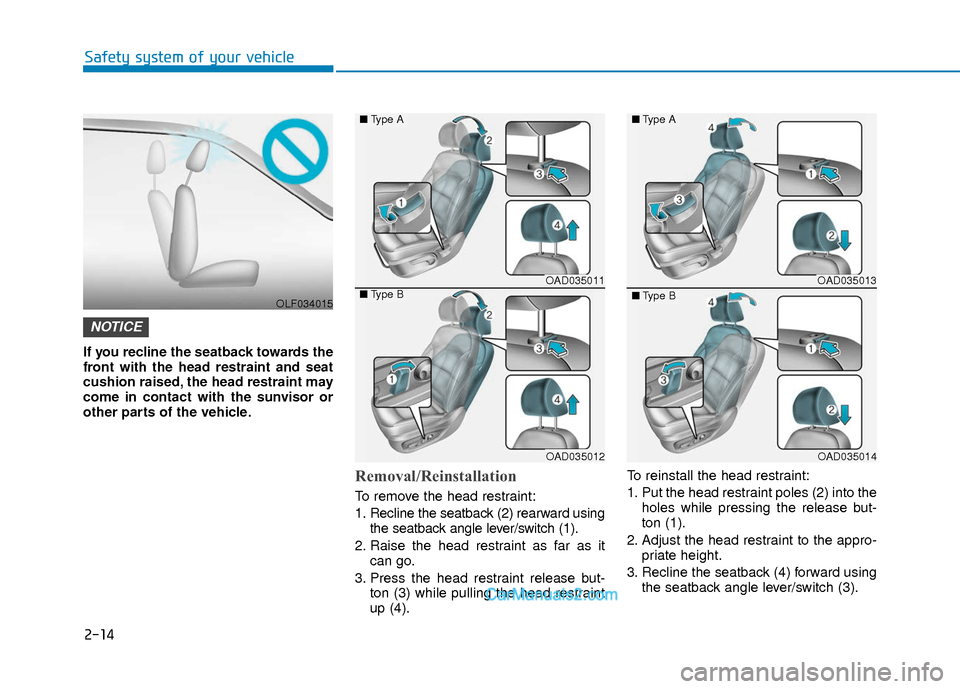
2-14
Safety system of your vehicle
If you recline the seatback towards the
front with the head restraint and seat
cushion raised, the head restraint may
come in contact with the sunvisor or
other parts of the vehicle.
Removal/Reinstallation
To remove the head restraint:
1. Recline the seatback (2) rearward usingthe seatback angle lever/switch (1).
2. Raise the head restraint as far as it can go.
3. Press the head restraint release but- ton (3) while pulling the head restraint
up (4). To reinstall the head restraint:
1. Put the head restraint poles (2) into the
holes while pressing the release but-
ton (1).
2. Adjust the head restraint to the appro- priate height.
3. Recline the seatback (4) forward using the seatback angle lever/switch (3).
NOTICE
OLF034015
OAD035011
OAD035012
■Type A
■Type BOAD035013
OAD035014
■Type A
■Type B
Page 44 of 526
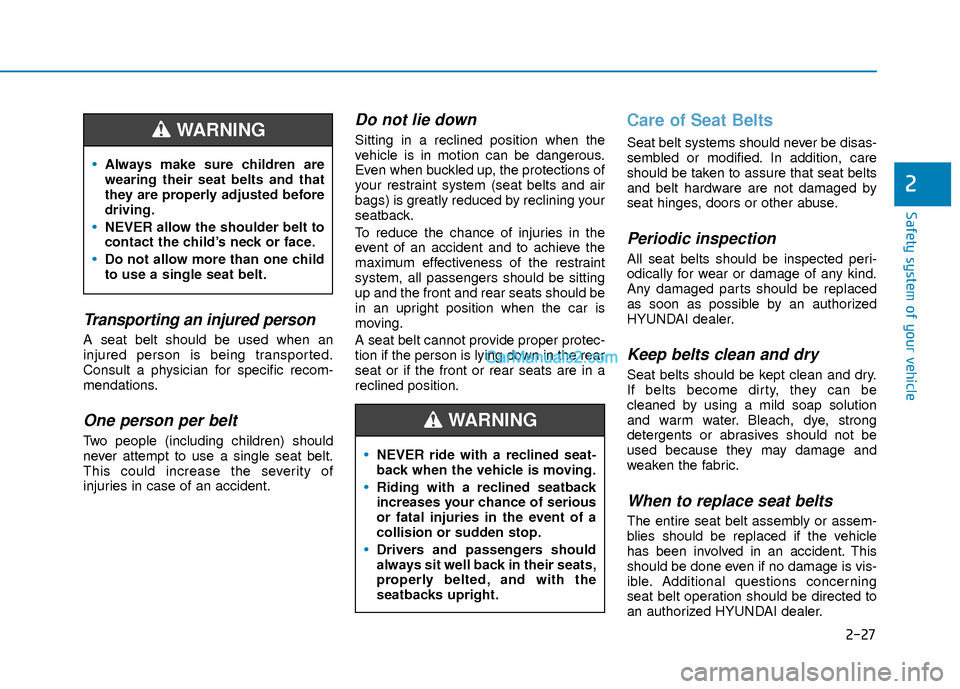
2-27
Safety system of your vehicle
2
Transporting an injured person
A seat belt should be used when an
injured person is being transported.
Consult a physician for specific recom-
mendations.
One person per belt
Two people (including children) should
never attempt to use a single seat belt.
This could increase the severity of
injuries in case of an accident.
Do not lie down
Sitting in a reclined position when the
vehicle is in motion can be dangerous.
Even when buckled up, the protections of
your restraint system (seat belts and air
bags) is greatly reduced by reclining your
seatback.
To reduce the chance of injuries in the
event of an accident and to achieve the
maximum effectiveness of the restraint
system, all passengers should be sitting
up and the front and rear seats should be
in an upright position when the car is
moving.
A seat belt cannot provide proper protec-
tion if the person is lying down in the rear
seat or if the front or rear seats are in a
reclined position.
Care of Seat Belts
Seat belt systems should never be disas-
sembled or modified. In addition, care
should be taken to assure that seat belts
and belt hardware are not damaged by
seat hinges, doors or other abuse.
Periodic inspection
All seat belts should be inspected peri-
odically for wear or damage of any kind.
Any damaged parts should be replaced
as soon as possible by an authorized
HYUNDAI dealer.
Keep belts clean and dry
Seat belts should be kept clean and dry.
If belts become dirty, they can be
cleaned by using a mild soap solution
and warm water. Bleach, dye, strong
detergents or abrasives should not be
used because they may damage and
weaken the fabric.
When to replace seat belts
The entire seat belt assembly or assem-
blies should be replaced if the vehicle
has been involved in an accident. This
should be done even if no damage is vis-
ible. Additional questions concerning
seat belt operation should be directed to
an authorized HYUNDAI dealer.
Always make sure children are
wearing their seat belts and that
they are properly adjusted before
driving.
NEVER allow the shoulder belt to
contact the child’s neck or face.
Do not allow more than one child
to use a single seat belt.
WARNING
NEVER ride with a reclined seat-
back when the vehicle is moving.
Riding with a reclined seatback
increases your chance of serious
or fatal injuries in the event of a
collision or sudden stop.
Drivers and passengers should
always sit well back in their seats,
properly belted, and with the
seatbacks upright.
WARNING
Page 64 of 526
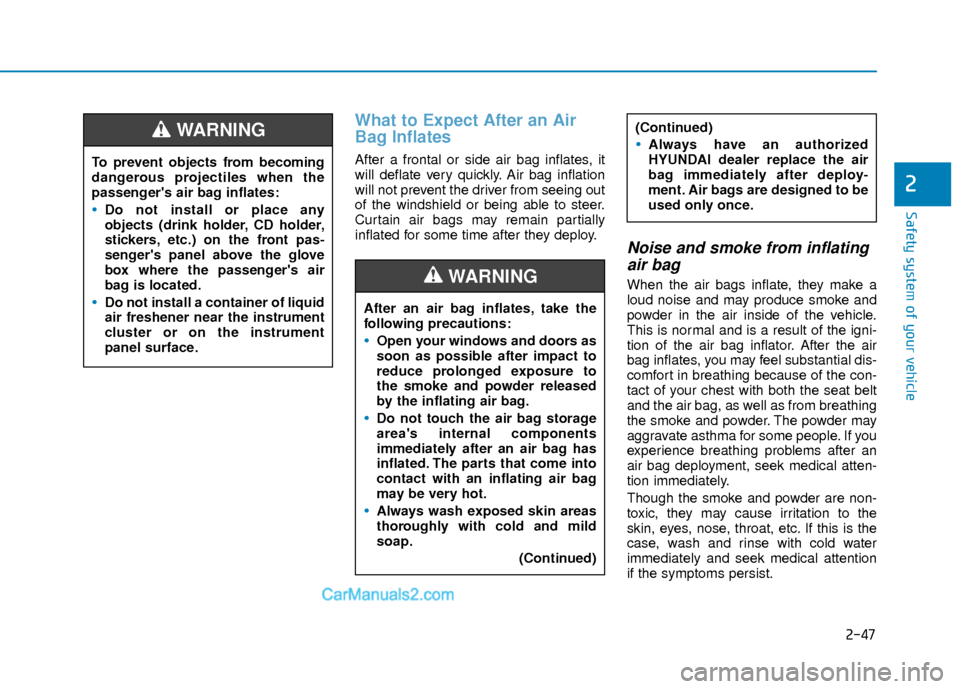
2-47
Safety system of your vehicle
2
What to Expect After an Air
Bag Inflates
After a frontal or side air bag inflates, it
will deflate very quickly. Air bag inflation
will not prevent the driver from seeing out
of the windshield or being able to steer.
Curtain air bags may remain partially
inflated for some time after they deploy.
Noise and smoke from inflatingair bag
When the air bags inflate, they make a
loud noise and may produce smoke and
powder in the air inside of the vehicle.
This is normal and is a result of the igni-
tion of the air bag inflator. After the air
bag inflates, you may feel substantial dis-
comfort in breathing because of the con-
tact of your chest with both the seat belt
and the air bag, as well as from breathing
the smoke and powder. The powder may
aggravate asthma for some people. If you
experience breathing problems after an
air bag deployment, seek medical atten-
tion immediately.
Though the smoke and powder are non-
toxic, they may cause irritation to the
skin, eyes, nose, throat, etc. If this is the
case, wash and rinse with cold water
immediately and seek medical attention
if the symptoms persist.
To prevent objects from becoming
dangerous projectiles when the
passenger's air bag inflates:
Do not install or place any
objects (drink holder, CD holder,
stickers, etc.) on the front pas-
senger's panel above the glove
box where the passenger's air
bag is located.
Do not install a container of liquid
air freshener near the instrument
cluster or on the instrument
panel surface.
WARNING
After an air bag inflates, take the
following precautions:
Open your windows and doors as
soon as possible after impact to
reduce prolonged exposure to
the smoke and powder released
by the inflating air bag.
Do not touch the air bag storage
area's internal components
immediately after an air bag has
inflated. The parts that come into
contact with an inflating air bag
may be very hot.
Always wash exposed skin areas
thoroughly with cold and mild
soap.
(Continued)
WARNING
(Continued)
Always have an authorized
HYUNDAI dealer replace the air
bag immediately after deploy-
ment. Air bags are designed to be
used only once.
Page 68 of 526

2-51
Safety system of your vehicle
2
ODH035900K
ODH035901K
ODH035902K
ODH035903K
Do not sit on the passenger
seat wearing heavily padded
clothes such as ski wear and
hip protector.
Do not use car seat acces-
sories such as thick blan-
kets and cushions which
cover up the car seat sur-
face.
Do not place electronic
devices such as laptops,
DVD player, or conductive
materials such as water bot-
tles on the passenger seat.
Do not use electronic
devices such as laptops and
satellite radios which use
inverter chargers.
If large quantity of liquid has
been spilled on the passen-
ger seat, the air bag warning
light may illuminate or mal-
function.
Therefore, make sure the
seat has been completely
dried before driving the vehi-
cle.
Do not place sharp objects on the front passenger seat. These may damage the occupant detection system, if they
puncture the seat cushion.
Do not place any items under the front passenger seat.
When changing or replacing the seat or seat cover, use original items only. The OCS has been developed based on
using original HYUNDAI car seats only. Altering or changing the authentic parts may result in system malfunction
and increase risk of injury when in collision. Any of the above could interfere with the proper operation of the OCS
sensor thereby increasing the risk of an injury in an accident.
(Continued)
Page 70 of 526
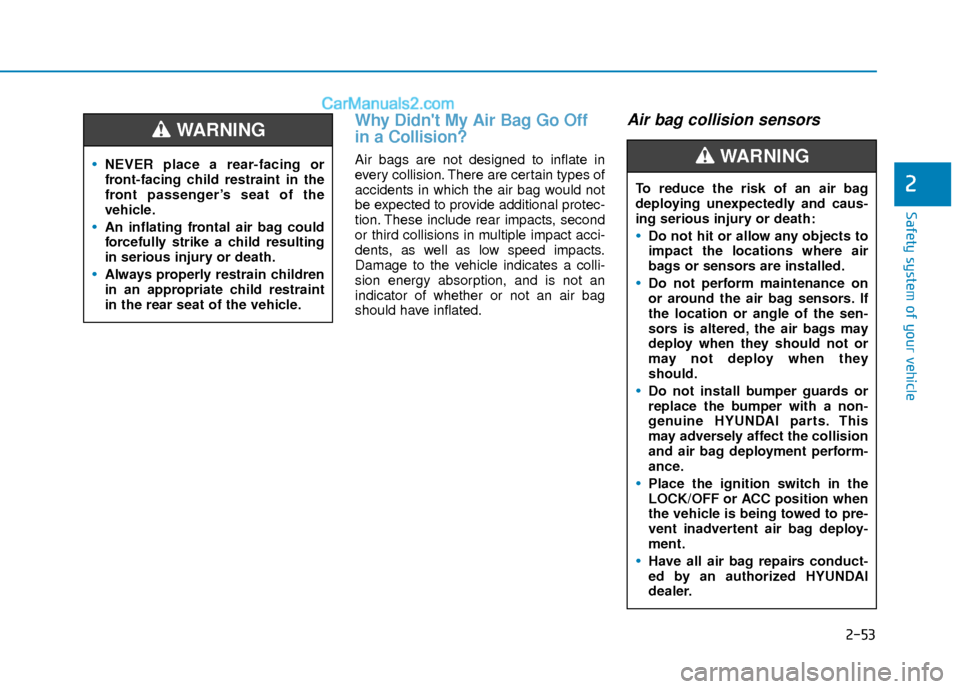
2-53
Safety system of your vehicle
2
Why Didn't My Air Bag Go Off
in a Collision?
Air bags are not designed to inflate in
every collision. There are certain types of
accidents in which the air bag would not
be expected to provide additional protec-
tion. These include rear impacts, second
or third collisions in multiple impact acci-
dents, as well as low speed impacts.
Damage to the vehicle indicates a colli-
sion energy absorption, and is not an
indicator of whether or not an air bag
should have inflated.
Air bag collision sensors
NEVER place a rear-facing or
front-facing child restraint in the
front passenger’s seat of the
vehicle.
An inflating frontal air bag could
forcefully strike a child resulting
in serious injury or death.
Always properly restrain children
in an appropriate child restraint
in the rear seat of the vehicle.
WARNING
To reduce the risk of an air bag
deploying unexpectedly and caus-
ing serious injury or death:
Do not hit or allow any objects to
impact the locations where air
bags or sensors are installed.
Do not perform maintenance on
or around the air bag sensors. If
the location or angle of the sen-
sors is altered, the air bags may
deploy when they should not or
may not deploy when they
should.
Do not install bumper guards or
replace the bumper with a non-
genuine HYUNDAI parts. This
may adversely affect the collision
and air bag deployment perform-
ance.
Place the ignition switch in the
LOCK/OFF or ACC position when
the vehicle is being towed to pre-
vent inadvertent air bag deploy-
ment.
Have all air bag repairs conduct-
ed by an authorized HYUNDAI
dealer.
WARNING
Page 75 of 526
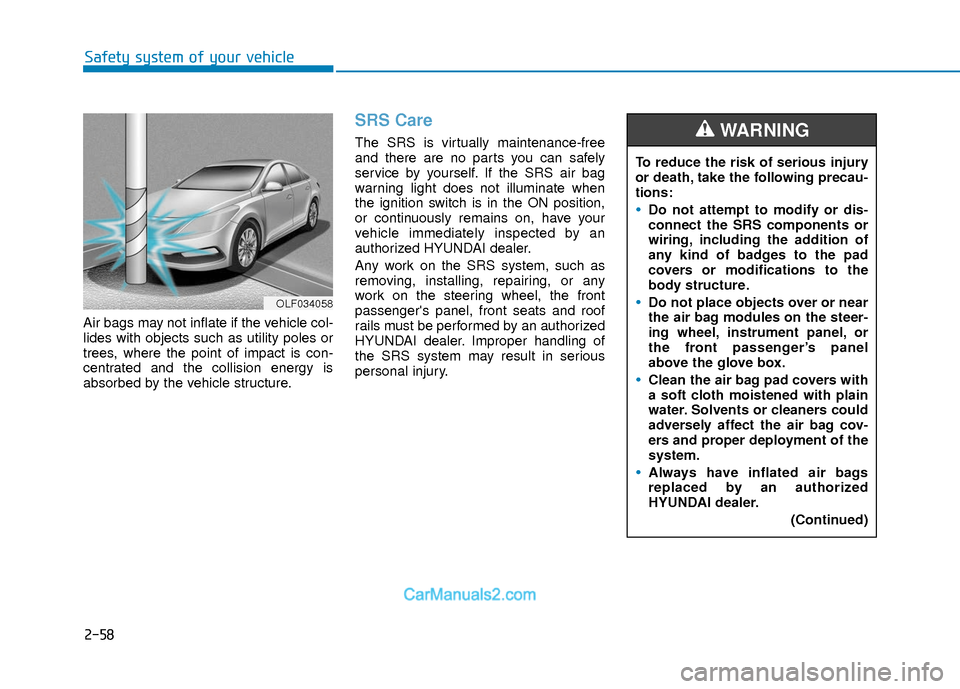
2-58
Safety system of your vehicle
Air bags may not inflate if the vehicle col-
lides with objects such as utility poles or
trees, where the point of impact is con-
centrated and the collision energy is
absorbed by the vehicle structure.
SRS Care
The SRS is virtually maintenance-free
and there are no parts you can safely
service by yourself. If the SRS air bag
warning light does not illuminate when
the ignition switch is in the ON position,
or continuously remains on, have your
vehicle immediately inspected by an
authorized HYUNDAI dealer.
Any work on the SRS system, such as
removing, installing, repairing, or any
work on the steering wheel, the front
passenger's panel, front seats and roof
rails must be performed by an authorized
HYUNDAI dealer. Improper handling of
the SRS system may result in serious
personal injury.To reduce the risk of serious injury
or death, take the following precau-
tions:
Do not attempt to modify or dis-
connect the SRS components or
wiring, including the addition of
any kind of badges to the pad
covers or modifications to the
body structure.
Do not place objects over or near
the air bag modules on the steer-
ing wheel, instrument panel, or
the front passenger’s panel
above the glove box.
Clean the air bag pad covers with
a soft cloth moistened with plain
water. Solvents or cleaners could
adversely affect the air bag cov-
ers and proper deployment of the
system.
Always have inflated air bags
replaced by an authorized
HYUNDAI dealer.
(Continued)
WARNING
OLF034058
Page 116 of 526
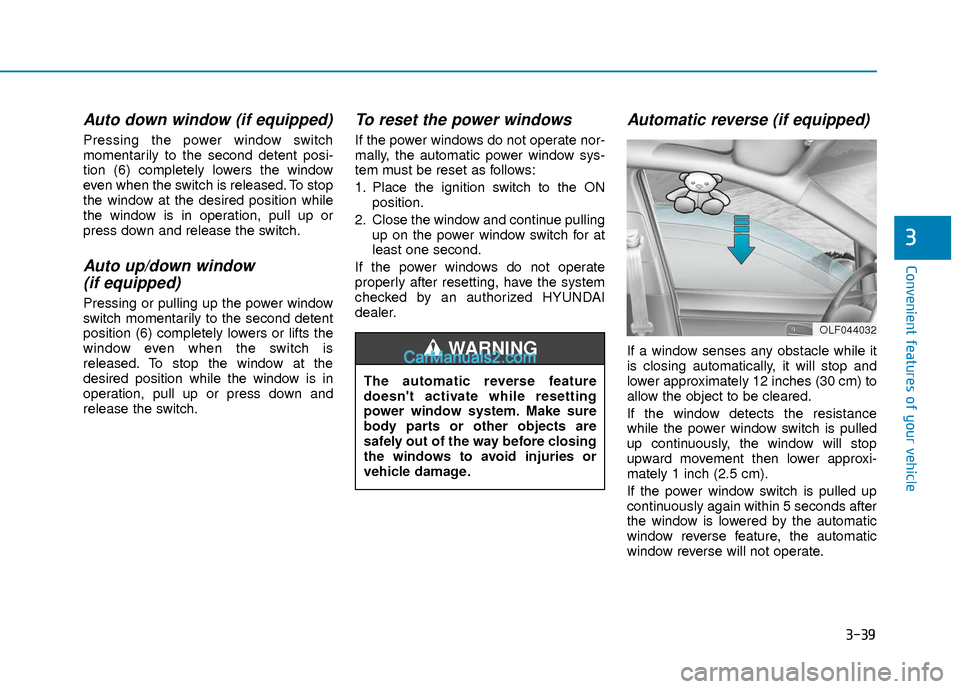
3-39
Convenient features of your vehicle
3
Auto down window (if equipped)
Pressing the power window switch
momentarily to the second detent posi-
tion (6) completely lowers the window
even when the switch is released. To stop
the window at the desired position while
the window is in operation, pull up or
press down and release the switch.
Auto up/down window (if equipped)
Pressing or pulling up the power window
switch momentarily to the second detent
position (6) completely lowers or lifts the
window even when the switch is
released. To stop the window at the
desired position while the window is in
operation, pull up or press down and
release the switch.
To reset the power windows
If the power windows do not operate nor-
mally, the automatic power window sys-
tem must be reset as follows:
1. Place the ignition switch to the ON
position.
2. Close the window and continue pulling up on the power window switch for at
least one second.
If the power windows do not operate
properly after resetting, have the system
checked by an authorized HYUNDAI
dealer.
Automatic reverse (if equipped)
If a window senses any obstacle while it
is closing automatically, it will stop and
lower approximately 12 inches (30 cm) to
allow the object to be cleared.
If the window detects the resistance
while the power window switch is pulled
up continuously, the window will stop
upward movement then lower approxi-
mately 1 inch (2.5 cm).
If the power window switch is pulled up
continuously again within 5 seconds after
the window is lowered by the automatic
window reverse feature, the automatic
window reverse will not operate.
OLF044032
The automatic reverse feature
doesn't activate while resetting
power window system. Make sure
body parts or other objects are
safely out of the way before closing
the windows to avoid injuries or
vehicle damage.
WARNING
Page 117 of 526
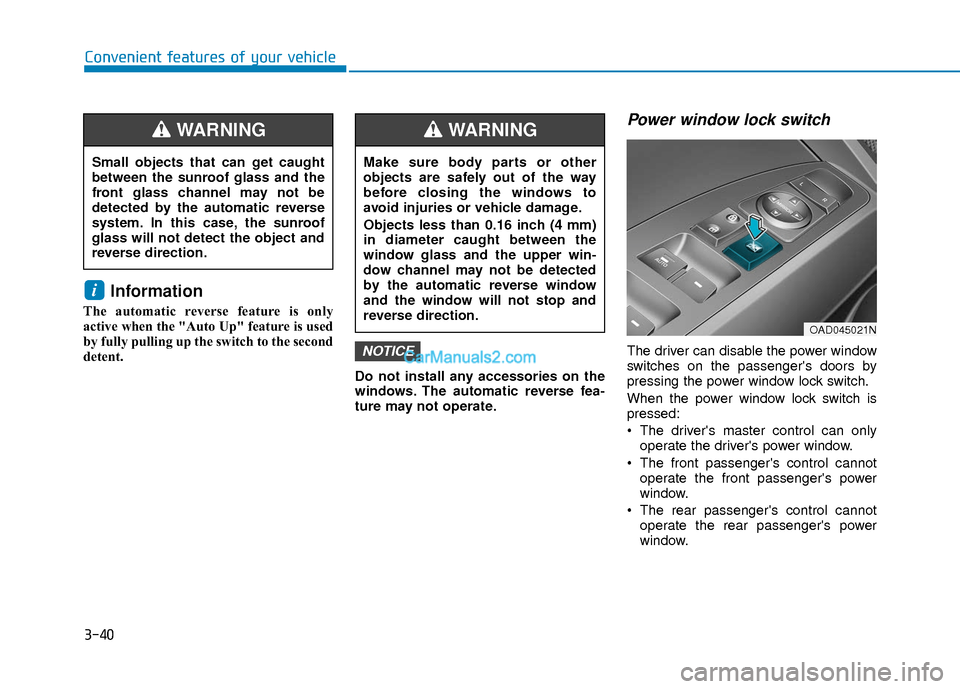
3-40
Convenient features of your vehicle
Information
The automatic reverse feature is only
active when the "Auto Up" feature is used
by fully pulling up the switch to the second
detent.Do not install any accessories on the
windows. The automatic reverse fea-
ture may not operate.
Power window lock switch
The driver can disable the power window
switches on the passenger's doors by
pressing the power window lock switch.
When the power window lock switch is
pressed:
The driver's master control can onlyoperate the driver's power window.
The front passenger's control cannot operate the front passenger's power
window.
The rear passenger's control cannot operate the rear passenger's power
window.NOTICE
i
OAD045021N
Make sure body parts or other
objects are safely out of the way
before closing the windows to
avoid injuries or vehicle damage.
Objects less than 0.16 inch (4 mm)
in diameter caught between the
window glass and the upper win-
dow channel may not be detected
by the automatic reverse window
and the window will not stop and
reverse direction.
WARNING
Small objects that can get caught
between the sunroof glass and the
front glass channel may not be
detected by the automatic reverse
system. In this case, the sunroof
glass will not detect the object and
reverse direction.
WARNING